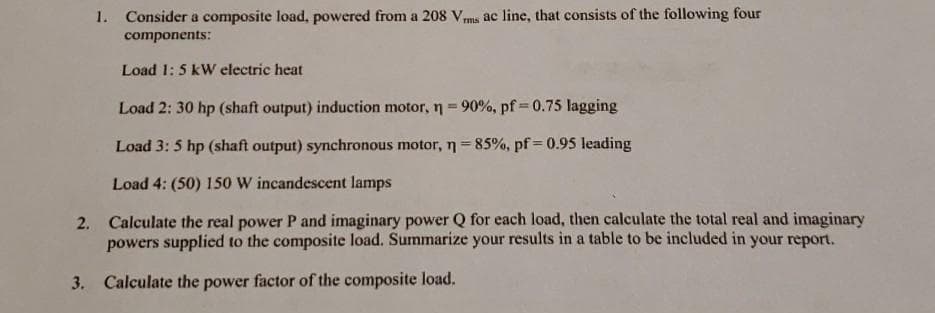1. Consider a composite load, powered from a 208 Vms ac line, that consists of the following four components: Load 1: 5 kW electric heat Load 2: 30 hp (shaft output) induction motor, n- 90%, pf 0.75 lagging Load 3: 5 hp (shaft output) synchronous motor, n=85%, pf= 0.95 leading %3D Load 4: (50) 150 W incandescent lamps 2. Calculate the real power P and imaginary power Q for each load, then calculate the total real and imaginary powers supplicd to the composite load. Summarize your results in a table to be included in your report. 3. Calculate the power factor of the composite load.
1. Consider a composite load, powered from a 208 Vms ac line, that consists of the following four components: Load 1: 5 kW electric heat Load 2: 30 hp (shaft output) induction motor, n- 90%, pf 0.75 lagging Load 3: 5 hp (shaft output) synchronous motor, n=85%, pf= 0.95 leading %3D Load 4: (50) 150 W incandescent lamps 2. Calculate the real power P and imaginary power Q for each load, then calculate the total real and imaginary powers supplicd to the composite load. Summarize your results in a table to be included in your report. 3. Calculate the power factor of the composite load.
Introductory Circuit Analysis (13th Edition)
13th Edition
ISBN:9780133923605
Author:Robert L. Boylestad
Publisher:Robert L. Boylestad
Chapter1: Introduction
Section: Chapter Questions
Problem 1P: Visit your local library (at school or home) and describe the extent to which it provides literature...
Related questions
Question

Transcribed Image Text:1. Consider a composite load, powered from a 208 Vms ac line, that consists of the following four
components:
Load 1: 5 kW electric heat
Load 2: 30 hp (shaft output) induction motor, n 90%, pf 0.75 lagging
Load 3: 5 hp (shaft output) synchronous motor, n= 85%, pf = 0.95 leading
Load 4: (50) 150 W incandescent lamps
2. Calculate the real power P and imaginary power Q for each load, then calculate the total real and imaginary
powers supplicd to the composite load. Summarize your results in a table to be included in your report.
3. Calculate the power factor of the composite load.
Expert Solution
This question has been solved!
Explore an expertly crafted, step-by-step solution for a thorough understanding of key concepts.
Step by step
Solved in 8 steps

Knowledge Booster
Learn more about
Need a deep-dive on the concept behind this application? Look no further. Learn more about this topic, electrical-engineering and related others by exploring similar questions and additional content below.Recommended textbooks for you

Introductory Circuit Analysis (13th Edition)
Electrical Engineering
ISBN:
9780133923605
Author:
Robert L. Boylestad
Publisher:
PEARSON

Delmar's Standard Textbook Of Electricity
Electrical Engineering
ISBN:
9781337900348
Author:
Stephen L. Herman
Publisher:
Cengage Learning

Programmable Logic Controllers
Electrical Engineering
ISBN:
9780073373843
Author:
Frank D. Petruzella
Publisher:
McGraw-Hill Education

Introductory Circuit Analysis (13th Edition)
Electrical Engineering
ISBN:
9780133923605
Author:
Robert L. Boylestad
Publisher:
PEARSON

Delmar's Standard Textbook Of Electricity
Electrical Engineering
ISBN:
9781337900348
Author:
Stephen L. Herman
Publisher:
Cengage Learning

Programmable Logic Controllers
Electrical Engineering
ISBN:
9780073373843
Author:
Frank D. Petruzella
Publisher:
McGraw-Hill Education

Fundamentals of Electric Circuits
Electrical Engineering
ISBN:
9780078028229
Author:
Charles K Alexander, Matthew Sadiku
Publisher:
McGraw-Hill Education

Electric Circuits. (11th Edition)
Electrical Engineering
ISBN:
9780134746968
Author:
James W. Nilsson, Susan Riedel
Publisher:
PEARSON

Engineering Electromagnetics
Electrical Engineering
ISBN:
9780078028151
Author:
Hayt, William H. (william Hart), Jr, BUCK, John A.
Publisher:
Mcgraw-hill Education,